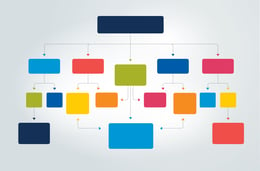Over the past 18 months, companies met new challenges associated with remote work, supply chain issues and other consequences of a global economic slowdown. As we head into 2022, digital transformation is more important than ever. According to the Gartner Technology Roadmap for 2021-2023, this time around, it’s not only about increasing the speed and efficiency of business processes -- technology investments must also enhance your company’s resilience.
 Resilience can be defined as the ability to rebound and preserve the viability of your business despite adversity and an unpredictable economic climate. Document management (DM), and other digital tools, are no longer only viewed as a cost center. They are recognized as an integral part of a company’s business strategy. Today, business process automation is the foundation on which companies build out products and services, and operate research & development, customer service, daily operations and talent acquisition.
Resilience can be defined as the ability to rebound and preserve the viability of your business despite adversity and an unpredictable economic climate. Document management (DM), and other digital tools, are no longer only viewed as a cost center. They are recognized as an integral part of a company’s business strategy. Today, business process automation is the foundation on which companies build out products and services, and operate research & development, customer service, daily operations and talent acquisition.
1. A strong technology foundation
 Now is the time to invest in a solid technology infrastructure to keep up with the pace of other companies that have already started the process. Installing a document management solution can jumpstart your digital transformation. It is a central hub for your company’s data, documents and workflow processes that allows authorized users to work from anywhere, on any device.
Now is the time to invest in a solid technology infrastructure to keep up with the pace of other companies that have already started the process. Installing a document management solution can jumpstart your digital transformation. It is a central hub for your company’s data, documents and workflow processes that allows authorized users to work from anywhere, on any device.2. Company-wide hyperautomation
 Process automation is essential in these areas:
Process automation is essential in these areas:- Signature authentication
- Onboarding and maintaining employee records
- Secure storage with built-in redundancy for disaster recovery
- Flexible access to keep processes running smoothly
- Smart productivity tools to file, search and track documentation and promote collaboration
- Workflow automation that drives critical business processes
3. A hybrid (not remote) workforce empowered by cloud-based solutions
 There is already a shift from a remote to a hybrid workforce, where employees work from both the office and from home. Due to this, using cloud technology is not optional anymore – it's a necessity. Companies are moving towards an “anywhere operations” model that allows them to produce and deliver products and services from anywhere in the world.
There is already a shift from a remote to a hybrid workforce, where employees work from both the office and from home. Due to this, using cloud technology is not optional anymore – it's a necessity. Companies are moving towards an “anywhere operations” model that allows them to produce and deliver products and services from anywhere in the world. 4. Trust architecture and zero-trust security
.jpg?width=280&name=purple%20arrow%20on%20black%20background%20(1).jpg) According to McKinsey’s Top Trends in Tech, “Zero-trust security is an approach to preventing data breaches by eliminating the concept of trust from an organization’s network architecture and instead following the principle of ‘never trust, always verify.’” So, while you want to go digital, you still need to invest in a high-quality cloud platform that provides you with top-notch security so you and your employees can continue to work efficiently, and you can be confident that your documents and data are secure.
According to McKinsey’s Top Trends in Tech, “Zero-trust security is an approach to preventing data breaches by eliminating the concept of trust from an organization’s network architecture and instead following the principle of ‘never trust, always verify.’” So, while you want to go digital, you still need to invest in a high-quality cloud platform that provides you with top-notch security so you and your employees can continue to work efficiently, and you can be confident that your documents and data are secure.
-1.jpg)

